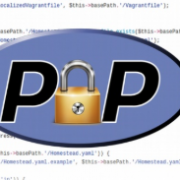Posts
Setting Cookie Secure Flag – PHP
/0 Comments/in kb /by AppSec LabsMethod #1 By using ini_set function
Add the following code on the page
ini_set("session.cookie_secure", 1);
Method #2 By using session_set_cookie_params function
Add the following code on the page:
session_set_cookie_params(0, NULL, NULL, TRUE, NULL);
Method #3 By using setcookie function
Add the following code when creating cookie:
setcookie("name", "value", NULL, NULL, NULL, TRUE, NULL);
References
https://www.owasp.org/index.php/SecureFlag
http://php.net/manual/en/function.setcookie.php
http://php.net/manual/en/function.session-set-cookie-params.php
Setting the HttpOnly Flag – PHP
/0 Comments/in kb /by AppSec LabsPHP supports setting the HttpOnly flag since version 5.2.0 (November 2006).
For session cookies managed by PHP, the flag is set either permanently in php.ini through the parameter:
session.cookie_httponly = True
Method#1 By using ini_set function before using setcookie function.
Add the following code on the page:
ini_set("session.cookie_httponly", 1);
setcookie("name", "value", NULL, NULL, NULL, NULL, TRUE);
Method#2 By using session_set_cookie_params function before using setcookie function
Add the following code on the page:
session_set_cookie_params(0, NULL, NULL, NULL, TRUE);
setcookie("name", "value", NULL, NULL, NULL, NULL, TRUE);
Method#3 By using setcookie function
Add the following code while creating cookie (not necessarily a session cookie):
setcookie("name", "value", NULL, NULL, NULL, NULL, TRUE);
References
http://php.net/manual/en/function.setcookie.php
http://php.net/manual/en/function.session-set-cookie-params.php
http://php.net/manual/en/session.configuration.php#ini.session.cookie-ht…
Prevention of Web Page Caching – PHP
/0 Comments/in kb /by AppSec LabsMethod
Add the following codes into the page, in order to prevent the page being cached
header('Cache-Control: no-cache, no-store, must-revalidate');
header('Pragma: no-cache');
header('Expires: 0');
Reference
http://wiki.asp.net/page.aspx/1487/prevent-browser-caching-of-web-pages-…
https://www.owasp.org/index.php/Testing_for_Logout_and_Browser_Cache_Man…(OWASP-AT-007)
SQLi – PHP Secure Coding
/0 Comments/in kb /by AppSec LabsMethod #1
Escaping special characters in a string for use in an SQL statement
<?php
$name = mysql_real_escape_string( $_POST[‘name’] );
$pwd = mysql_real_escape_string( $_POST[‘pwd’] );
$str_sql = "SELECT * from `tbl_users` WHERE " .
"usr_name=’" . $name . "’ AND " .
"usr_pwd=’" . $pwd . "’";
$result = mysql_query( $str_sql ) or die ( mysql_error() );
?>
Method #2
Using prepared statements and parameterized queries:
Case #1
While connecting to database
<?php
$pdo = new PDO('mysql:dbname=db;host=127.0.0.1;charset=utf8', 'username', 'password');
$pdo->setAttribute(PDO::ATTR_EMULATE_PREPARES, false);
$pdo->setAttribute(PDO::ATTR_ERRMODE, PDO::ERRMODE_EXCEPTION);
?>
Case #2
While retrieving data
<?php
$stmt = $pdo->prepare('SELECT * FROM tables WHERE name = :name');
$stmt->execute(array(':name' => $name));
foreach ($stmt as $row) {
echo $row[0];
}
?>
Case #3
While inserting
<?php
$preparedStatement = $pdo->prepare('INSERT INTO table (column) VALUES (:column)');
$preparedStatement->execute(array(':column' => $unsafeValue));
?>
This technique can also be applied in case of update and delete.
References
http://php.net/manual/en/security.database.sql-injection.php
http://php.net/manual/en/function.mysql-real-escape-string.php
http://php.net/manual/en/book.pdo.php
Anti CSRF Token – PHP
/0 Comments/in kb /by AppSec Labs
1. Add a unique token to the hidden field of user form on submit and store it on the session. Add the following codes to achieve this.
<?php
$token = md5(uniqid(rand(), TRUE));
$_SESSION[“token_$token”] = time();
?>
<form action="login.php" method="post">
<input type="hidden" name="token" value="<?php echo $token; ?>" />
<p>
Username: <input type="text" name="username" /><br />
Password: <input type="text" name="password" /><br />
<input type="submit" value="Login" />
</p>
</form>
2. Before processing, validate the token on serverside.
<?php
if (isset($_SESSION['token_' . $_POST['token']])
{
// prevent use the token twice
unset($_SESSION['token_' . $_POST['token']]);
/* Valid Token */
}
?>
3. The validity of token can also be limited
<?php
$token_age = time() - $_SESSION['token_time'];
if ($token_age <= 600)
{
/* Less than ten minutes has passed. */
}
?>
XSS – PHP Secure Coding
/in kb /by AppSec LabsCase #1
HTML escape before inserting untrusted data into HTML element content.
<?php $str=$_POST["data"]; $str_safe=htmlspecialchars($str, ENT_QUOTES); ?> <h1><?php echo $str_safe; ?></h1>
Case #2
JavaScript escape before inserting untrusted data into JavaScript data values.
<?php
$str=$_POST["data"];
$safe=strip_tags($str);
?>
<script>alert("<?php echo $safe; ?>");</script>
References
http://php.net/manual/en/function.htmlspecialchars.php
http://php.net/manual/en/function.htmlentities.php
http://in3.php.net/strip_tags
Categories
Archive
- December 2020
- September 2020
- June 2020
- March 2020
- July 2017
- May 2017
- March 2017
- February 2017
- January 2017
- December 2016
- September 2016
- July 2016
- June 2016
- May 2016
- April 2016
- March 2016
- January 2016
- December 2015
- August 2015
- June 2015
- May 2015
- March 2015
- February 2015
- January 2015
- December 2014
- September 2014
- July 2014
- June 2014
- May 2014
- April 2014
- March 2014
- January 2014
- December 2013
- November 2013
- December 2012
- September 2012
- February 2012
- October 2011
- September 2011
- August 2011


